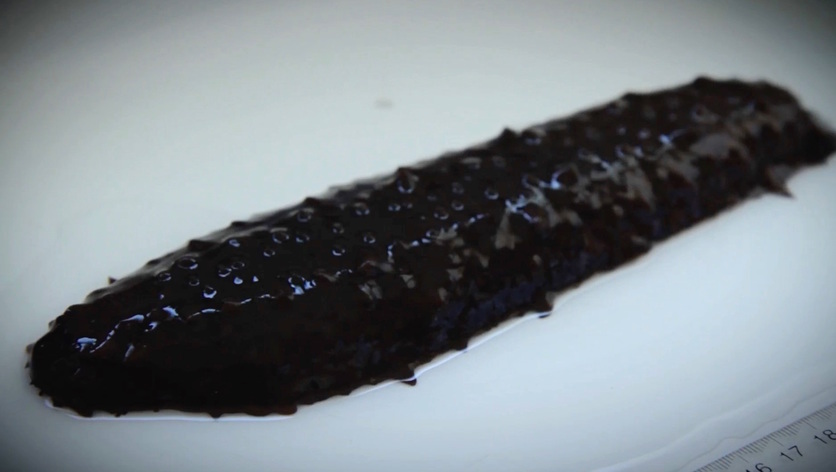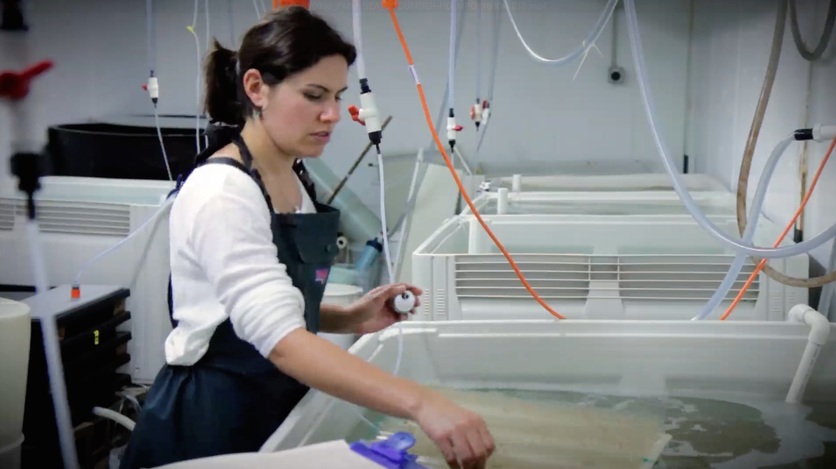Iwi and marine biologists are curious to know whether the New Zealand native sea cucumber can become a valuable export product while also reducing the environmental impact of aquaculture.
Innovation in business often requires scientific partnerships to investigate product viability. With many iwi and Māori investment groups looking at ways they can commercially maximise their assets sustainably, kei te tahuri rātou ki ngā mātanga pūtaiao (they’re turning to scientists) to help them realise their vision.
Dr Ocean Mercier
The endemic sea cucumber (Stichopus mollis) isn’t a common menu item in Aotearoa, but it is popular in Asian cuisine. Dried sea cucumber also has value as a health supplement to alleviate symptoms associated with arthritis. A few businesses have tried to set up sea cucumber export industries. Although sea cucumbers are plentiful, wild specimens must be hand-gathered by divers. This makes it difficult to ensure the steady supply that the export market demands.
An attractive business opportunity
Iwi involved in aquaculture see culturing sea cucumbers as an exciting opportunity. By producing multiple species on the same farm, growers can increase their income and reduce the risks associated with growing a single species. Farmed sea cucumbers can provide a reliable product supply and can also benefit the environment. Sea cucumbers feed on detritus and live off the waste produced by mussel farms. Utilising the waste as a feed base fits well with the principles of sustainability and kaitiakitanga.
The business edge of science
Chinese company Oriental Ocean Limited is working with Māori investors. While visiting a mussel farm, Oriental Ocean staff noticed how closely the New Zealand native sea cucumber resembles a species of sea cucumber that is cultured in China. Chinese scientists brought their skills to New Zealand and began collaboration with marine biologist Kimberley Maxwell at NIWA’s Mahanga Bay Aquaculture Research Facility.
This type of research was a first for New Zealand aquaculture. Scientists were aware of the sea cucumber life cycle but not how long it takes the species to grow from an egg to an adult. By modifying the Chinese techniques, Kimberley and the team collected adult Stichopus mollis from Wellington Harbour and spawned and then nurtured the fertilised eggs through several developmental stages. The larvae were kept in tanks and fed powdered seaweed and silt. Juvenile sea cucumbers were transferred to Mahanga Bay where they lived in an environment similar to a commercial mussel farm.
Kimberley’s research was successful in that it established some baseline data for sea cucumber reproduction and growth rates. However, it also established that, due to the labour and running costs at that point in time, growing sea cucumbers in a hatchery was not commercially viable.
Scientific research isn’t something that is ever considered ‘finished’. Scientists regularly use information from past research to help shape new investigations. A few years after Kimberley’s research, Auckland University PhD student Leo Zamora discovered that sea cucumbers grow faster at lower temperatures. Provided they have sufficient food, the sea cucumbers’ growth rate nearly tripled when farmed in cooler water.
Potential economic benefits may outweigh the lengthy development time
Paul Morgan of Wakatū Incorporation says that perfecting aquaculture systems takes time. He recognises that a top-quality product often requires ongoing development, but the economic benefits may be worth the extra investment. Integrating sea cucumbers into mussel beds allows growers to maximise production of sea cucumbers while reducing the the environmental impact of the mussel farming.
Nature of science
Scientific success and commercial success can be quite different. Kimberley Maxwell’s research was successful in that it established baseline data for sea cucumber growth rates. It also established that the hatchery protocols in use were too costly to make a commercially viable product. Further investigations may lead to new hatchery protocols and potential commercial success.
Consumers are willing to pay a lot of money for natural products with low environmental impacts – adding value to an already high-value product. At $300 per kilogram, sea cucumbers are seen as a significant export product, but growers must be able to provide a reliable, cost-efficient supply. Continued scientific investigation may help turn the rather unattractive sea cucumber into a very attractive business.
Innovation
The process of identifying an opportunity – like co-culturing mussels and sea cucumbers – and turning it into a money-making business requires innovative thinking and action. It also highlights the often lengthy product development process that happens behind the scenes and the role science plays in getting new ideas to market.
The Hub offers a number of innovation stories that explore product development and the innovative thinking and skills needed to launch them. Find out about of few of the products in the article Introducing innovation.
New Zealand aquaculture
Green-lipped mussels are New Zealand’s major aquaculture species. Learn more about how they are farmed and the value they add to the economy. Explore the mussel life cycle in the activity Similarities and differences: wild and farmed green-lipped mussels.
Useful links
Read this Victoria University of Wellington profile on Dr Ocean Mercier. In 2019 the Royal Society of New Zealand Te Apārangi awarded her the 2019 Callaghan Medal, read more in “A bridge between worlds” – physical science and mātauranga Māori.
Associate Professor Ocean Mercier explains how she draws on the best from two knowledge systems to resolve environmental issues in this Where I work article in Nature.
See Kimberly Maxwell's profile on the Moanea Project website.
Leo Zamora discusses his sea cucumber research in this New Zealand Herald article.
The NIWA article A first for New Zealand: culturing our endemic sea cucumber for overseas markets details research carried out from 2007–2009, including images and other information about the sea cucumber life cycle.
Acknowledgement
Project Mātauranga
Watch Series 2/Episode 6 The Sea Cucumber: Innovation in Iwi Exports
Project Mātauranga is a television series that investigates Māori world views and methodologies within the scientific community and looks at their practical applications. Each of the 13 episodes in series 2 shows how western science and Māori knowledge systems are combining to provide solutions to a variety of challenges.
The Science Learning Hub thanks Scottie Productions for allowing us to host these videos.



